This post focuses on how to make sourdough bread in a bread machine using an active sourdough starter along with flour, water, salt, and a little yeast. If you’re looking for a sourdough sandwich bread to make in the bread machine, you might enjoy this easy method.
This bread actually tastes more sour the next day so unless you’re in a big hurry to eat it, let it rest in a bread bag on the counter overnight. Or if you want a more sour flavor, follow the directions above for the sourest of sourdoughs.
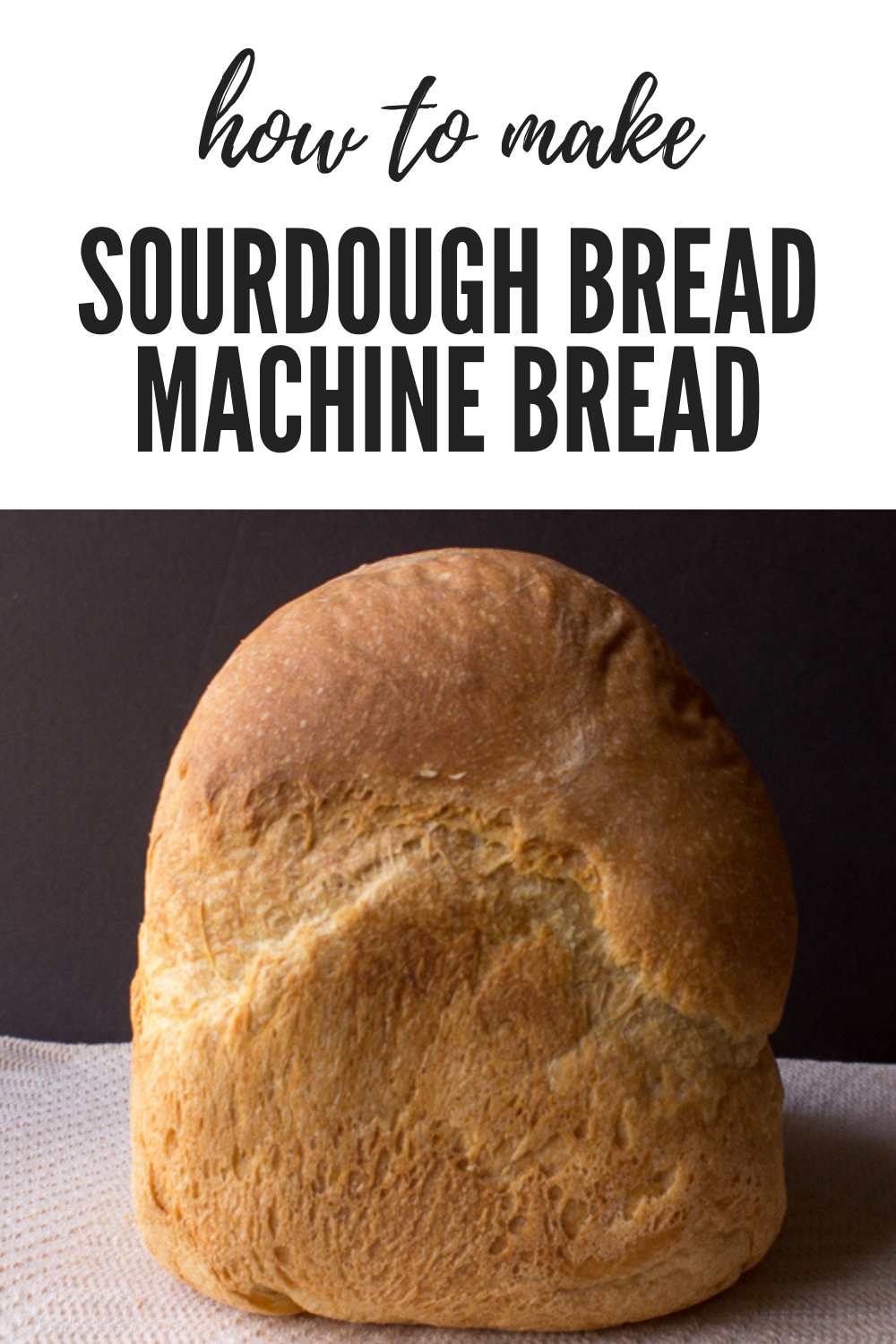
The first time I made this bread was in 2008. I remade it in January 2017 and made some edits to the post in addition to updating the photos. The original recipe remains the same.
I used the starter I created from a recipe from Boudin Bakery in San Francisco. It took me awhile to get the flavor of the starter right. I had to throw it away a couple of weeks after I started it because it turned pink. I started it again and it was fine after that.
Sourdough Starter Recipe
From Boudin Bakery http://www.exploratorium.edu/cooking/bread/recipe-sourdough.html
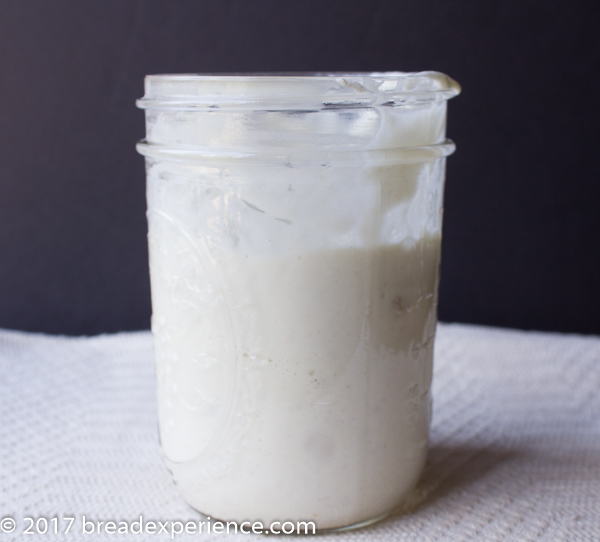
Ingredients:
- 1 small handful (1/4 – 1/3 cup / 31.25 g – 41.67 g ) white, unbleached all-purpose flour
- 1 or 2 Tbsp / 14.8 g – 29.6 g water
Tools & equipment
- a small bowl
- a towel, napkin, or other piece of cloth (not terry)
- a large spoon
Directions:
- In a mound of flour, make a small well and add the water.
- Slowly mix the flour and the water, bringing more flour into the center of the well. The mixture will gradually transform from a paste into a small piece of dough.
- Knead this small piece of dough with your fingers for about 5-8 minutes, until it becomes springy.
- Place the dough in a small bowl, cover it with a damp towel, and let it sit in a warm spot for 2 or 3 days.
- When it’s ready, the dough will be moist, wrinkled, and crusty. If you pull off a piece of the crust, you’ll find tiny bubbles and smell a sweet aroma.
- Throw away any hardened crust. “Refresh” the remaining piece by mixing it with twice the original amount of flour and enough water to make a firm dough. Set aside as before.
- After 1 or 2 days the starter will have a new, fresh look. Remove any dried dough and mix with about 1 cup of flour.
- Once again, cover the bowl with a damp cloth and leave it in a warm place for another 18-12 hours.
- When the starter is ready, it will appear fully risen, and a small indentation made with a finger won’t spring back.
Now the starter is ready to be used in virtually any sourdough recipe.
Remember to save a small piece of the starter: You can put it in the refrigerator for several days, then refresh it again as above and use it to make another loaf. A good starter will serve you for years to come!
Using the starter to make bread
Step 1:
Up to 12 hours before beginning the recipe, stir the starter and discard 1 cup. Feed the remaining starter with 1/2 cup water and 1 cup flour. Let it sit for 4 to 12 hours before using in a recipe.
Step 2: Use however much “fed starter” the recipe calls for, and feed the remainder with 1/2 cup water and 1 cup flour. Let this remaining starter sit at room temperature for 2 to 4 hours, until bubbly, then cover and refrigerate.
Tip: If you’re not planning to use your starter for over a week, take it out and feed it once a week with 1/2 cup water and 1 cup flour. Start by discarding (or using) 1 cup of the starter. After mixing in more flour and water, you can return the starter to the refrigerator without waiting for it to get bubbly first. (I usually let it sit on the counter for a couple of hours even if I plan on returning it to the refrigerator because it gives it better flavor for the next batch of bread).
Look for more tips on maintaining a sourdough starter.
Now it’s time to make some basic sourdough bread in the bread machine.
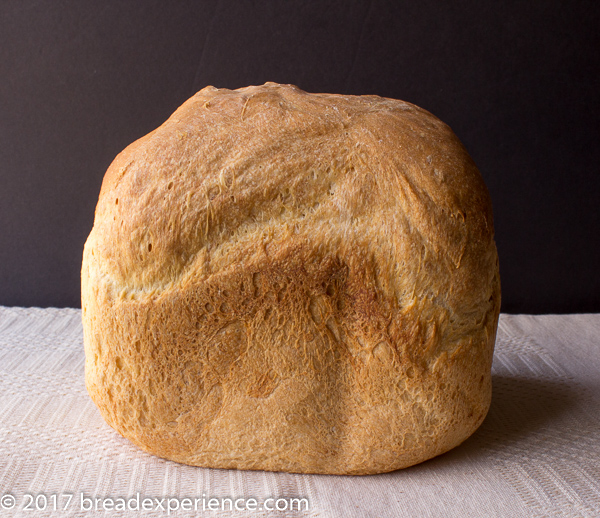
Basic Sourdough Bread Machine Bread
I used a basic sourdough bread recipe courtesy of Fleischmann Yeast and the “wild yeast” starter I created using the method above.
Ingredients:
1-Pound Loaf
- 3/4 cup / 188 g sourdough starter (100% hydration)
- 1/4 cup / 59 g water
- 1 Tbsp / 14 g butter
- 3/4 tsp / 4.5 g salt
- 2 cups / 254 g bread flour
- 2 tsp / 8.38 g sugar
- 1-1/2 tsp bread machine yeast
1-1/2 Pound Loaf
- 1-1/4 cups / 313 g sourdough starter (100% hydration)
- 1/3 cup / 79 g water
- 1 Tbsp / 14 g butter
- 1 tsp / 6 g salt
- 3 cups / 381 g bread flour
- 1 Tbsp / 12.6 g sugar
- 2 tsp / 6.3 g bread machine or instant yeast
Note:This version makes a mild sourdough bread. I like the bread machine sourdough that way because I use it for sandwich bread. If you prefer a more sour flavor, do the following before you mix the ingredients in the machine:For the sourest Sourdough:
In a medium bowl, combine the water, starter, and half the flour. Cover and let the mixture stand for 24 hours until very sour and bubbly. Then combine the mixture with the remaining ingredients in the bread pan, use the recommended cycle (listed below) and press start.
Directions:
Use the 1-pound recipe if your machine pan holds 10 cups or less of water. Add ingredients to bread machine pan in the order suggested by manufacturer. (If dough is too dry or stiff or too soft or slack, adjust dough consistency – see tips below.)
Edited on 1/28/2017: If you use a 100% hydration sourdough starter, the amounts for the water should be okay. However, if you use a stiffer starter, you’ll need to increase the water. I had to add 1/2 cup instead of 1/4 cup of water for the 1-pound recipe which is the size I tested today.
I used the recipe for the 1 pound loaf although my bread machine can handle the 1 1/2 pound loaf as well.
Here are the ingredients in the pan in the appropriate order for my bread machine. I made a well in the center for the yeast so it doesn’t make contact with the liquid ingredients as the manufacturer suggests. If your bread machine indicates the ingredients should be placed in a different order, then follow those instructions.
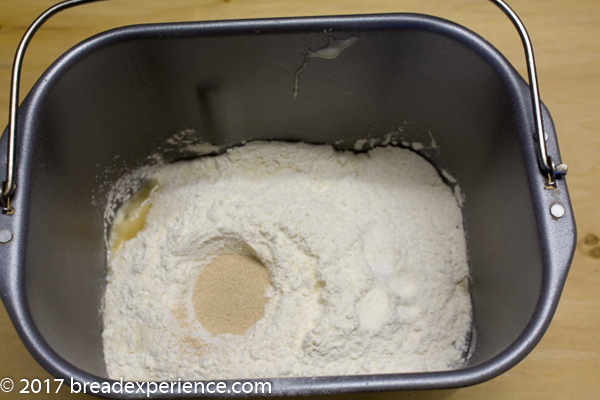
Recommended cycle:
Basic/white bread cycle; medium/normal color setting. Timed-bake feature can be used.
Adjusting Dough Consistency: After mixing for a few minutes, the ingredients should turn into a smooth ball around the kneading blade. If the dough appears too stiff or too soft, add more liquid or flour in 1 teaspoon increments, until the proper consistency is reached. Do not add more than 3 to 4 teaspoons liquid or flour. The machine can not compensate for wide variations and may not bake the larger amount of dough thoroughly.
Once the bread has finished the bake cycle, remove from the pan to a wire rack to cool before slicing and serving.
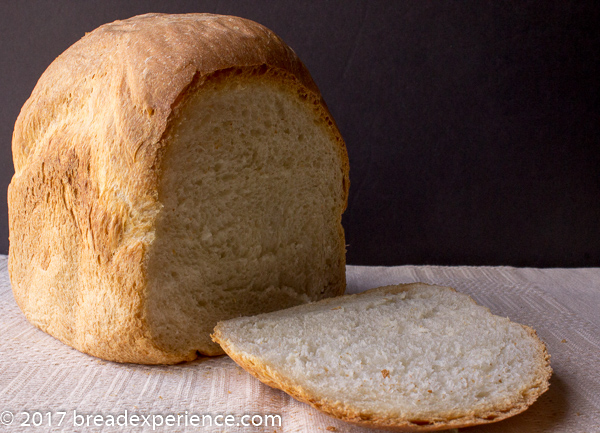
Happy Baking!
Cathy
Anonymous says
Thannks for the new view–there are a lot of sourdough starter recipes and sourdough breads online that simply don’t work. I hope this one does. I will try it out and post tomorrow night.
Cathy (breadexperience) says
Hi Anonymous! Thanks for visiting. It’s been awhile since I’ve made this bread so do let me know if you like it. I liked the fact that it could be made in the bread machine.
4159b948-cdd6-11e0-b6b0-000bcdcb5194 says
First time working with a sourdough starter and I want to eventually use this to make several loaves at a time. If I want to “grow” this starter, can I keep feeding it w/o discarding for a few weeks?
jes1776 says
If you use the over night method can you skip the two tsp of yeast?
Cathy W. says
Hi Jes, This bread needs a longer fermentation in order to develop sufficient volume. If your machine has a cycle with a long second rise (perhaps a French bread cycle), then you could probably reduce the yeast by about 1/2 tsp, but I wouldn’t omit the add’l yeast altogether.
Jessey says
There is no yeast in starter, is that in error?
Cathy says
Hi Jessey, the starter will be the leavening or “wild yeast” in this bread. No additional dried yeast is necessary in the starter; however, there is additional yeast in the final dough.
Laura says
I love all the sourdough possibilities you have provided for us. I’ve used your classic recipe with my own variations and it turned out great. I want to do a bread machine version but don’t want to use yeast or sugar and I’d like to use a sprouted rye flour. Any suggestions? Thanks 🙂
Cathy says
Hi Laura,
I haven’t tried using only sprouted rye in a bread machine recipe. Are you going to incorporate bread flour as well? If not, it could be fairly dense. IF you don’t mind using molasses, you might try this recipe and just use your starter instead of the yeast https://www.breadexperience.com/rye-bread-recipe/ or this one that uses honey https://www.breadexperience.com/beer-rye-bread-in-bread-machine/.
Happy Baking!
Cathy
Gilda says
I have made this 3 times in the last month. We like it. I had to add an additional 3 teaspoons of water during the kneading stage
Cathy says
Hi Gilda, thanks for sharing. It’s always a good idea to watch the dough even in a bread machine. I’ve had to add extra water sometimes as well depending on the temperature in my kitchen.
Cl says
What’s the percentage of starter in to 100 % of bread flour? Thanks
I m confused about the right amount to use in a loaf of bread..
Cathy says
Hello Clancy, are you referring to the amount of sourdough you need to use to make this sourdough bread machine loaf? If so, it’s 3/4 cup for a 1-pound loaf and 1 1/4 cups for a 1 1/2-pound loaf. If you are referring to making sourdough bread in general, typically you’ll use about 20 percent, but if you allow the dough to ferment overnight or longer, you can get away with using less sourdough.
Emma Petchey says
absolute failure! Turned out like a large scone. I followed the 24 hour sitting method and then added everything in order of bread machine. Not sure why it never rose any more. Perhaps too dry?
Cathy says
Hi Emma,
I’m sorry to hear your sourdough bread machine bread didn’t turn out right. Did you add the dried yeast as well to give it a boost?
I had this happen to me when I made a different sourdough bread machine bread. The first time I made the bread, it turned out flat because my starter wasn’t active enough, and I didn’t add any extra yeast. The 2nd time I made the loaf, I added the extra yeast and it rose very nicely. Refer to this post https://www.breadexperience.com/making-sourdough-bread-using-natural/
Judy Pitsinger says
I am diabetic. What to use instead of sugar. All so I am not to use salt. Is that a problem??????
Cathy says
Hi Judy, you can use honey instead of sugar if it is allowed in your diet. I haven’t tried making this bread without salt, but I do know that omitting salt affects the browning of the bread as well as the flavor. It might also make the bread more crumbly.
Mike S. says
I used to make yeast bread a long time ago, slavishly following a recipe. But now during the pandemic, yeast is impossible to find (I had a very little in the fridge), so I decided to try homemade sourdough starter. I love sourdough bread. I just mixed water and flour to a thin batter consistency, and within days (with some feedings) it was bubbling and nice and sour. I ditched recipes (still making sure to use some salt and olive oil) and just went by dough consistency: if it’s slightly sticky.
I have an old-fashioned stove with pilot light, so I use the pilot-warm oven for fermenting stuff.
I took a little of my remaining yeast and started a culture (shake often) with sugar water, but it’s total guesswork how much of this suspension to use. I add about a tbsp suspension and a tsp sugar to sourdough to help it raise faster, but results are variable.
Note to Judy (above): if you let the yeast or sourdough culture work long enough, it uses up most of the sugar, converting it to gas and alcohol. The sugar is microbe fuel. I could tell that my bread machine basic recipe didn’t let it raise long enough, because I could still taste the sugar in the bread.
Bread machines also became impossible to find, but we found one in a thrift shop. No sourdough advice in the online pdf manual, so I was glad to read your material. It’s now too hot to run the oven, so I want to use the bread machine. Outdoors 🙂 . Thanks!
Questions:
I like to mix about 10% to 20% multigrain flour for flavor. How would this affect the sourdough culture for bread machines?
Do you have any suggestions on how to use/measure the cultured yeast? Are there any precautions I should be aware of? Can I dry the cultured yeast to emulate store-bought?
Cathy says
Hi Mike, thank you for your comments.
I haven’t used cultured yeast in the manner you mentioned. However, you can dry a regular sourdough starter. I haven’t tried using it dried in a recipe although I think you can. I have stored it in the refrigerator dry for several months and restarted it later. This is a good way to reserve some starter in case for some reason the liquid (activated) form gets thrown out or goes bad.
I’m not clear if you are saying you like to add multigrain flour to your starter or the final dough, but adding a bit of whole wheat flour to the sourdough starter will increase the activity. Adding multigrain flour to the final dough will make a heavier bread. You will probably want to increase the hydration.
Rick says
Just a note about buying a bread machine from thrift stores: nine and a half times out of ten the kneading paddle will be missing. Take down the name and model number of the machine and search to see if you can obtain that part before buying a used machine. Kneading paddles are not universal and are seldom interchangeable between machines.
Cheryl says
Really do need 1/2 cup water for 1.5 lb loaf.
Cathy says
Thanks for the suggestion! As with any bread, the hydration can be adjusted as needed.